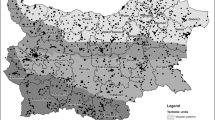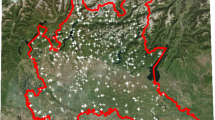Abstract
Acknowledged as a significant health hazard, increasing attention has been given to indoor and geogenic radon for some 20 years. One part of the efforts is surveying in order to assess the geographical extent of the hazard. Results acquired in surveys serve to support decisions in radon abatement policy, aimed to reduce exposure and consisting in prevention, mitigation and remediation measures. One particular element is delineation of so-called radon priority areas, or areas in which the hazard is such that abatement measures should be implemented with priority. These areas are estimated from radon measurements supported by different modelling methods. Methods which are based on estimating local probabilities that radon concentration exceeds a reference level often rely on measures of local variability, expressed for example by the geometric standard deviation or the coefficient of variation, because these describe the shape of the distribution whose tail areas are the sought-after probabilities. Evidently, delineation of radon priority areas thus depends, apart from mean concentration, on dispersion within the area whose priority status shall be assessed. A second use of spatial variability measures of radon is survey planning, because the sample size necessary to estimate a mean with given precision depends on the dispersion of the quantity to be assessed. It is estimated through pilot surveys or derived from general knowledge. The large radon databases accumulated for years allow more detailed insight into spatial properties of dispersion, some of which are discussed in this paper, in the first place the relation between local dispersion and mean and sampling density. Not least, they also grant insight—so far mostly speculative—about the process, understood as a stochastic process, which generates the spatial dynamic. Main conclusions are that a proportional effect in logarithmic scale exists and has an effect on estimation of local exceedance probability and that one should keep in mind that results, for example the local status as a radon priority area, depend on the estimation method.








Similar content being viewed by others
References
Agterberg FP (1984) Use of spatial analysis in mineral resource evaluation. J Int Assoc Math Geol 16(6):565–589. https://doi.org/10.1007/bf01029317
Agterberg FP (2007a) Mixtures of multiplicative cascade model in geochemistry. Nonlin Processes Geophys 14:201–209. https://doi.org/10.5194/npg-14-201-2007
Agterberg FP (2007b) New applications of the model of de Wijs in regional geochemistry. Math Geol 39(1):1–25. https://doi.org/10.1007/s11004-006-9063-7
Agterberg F (2015) Self-similarity and multiplicative cascade models. J South Afr Inst Min Metall 115:1–11
Beard LR (1960) Probability estimates based on small normal-distribution samples. J Geophys Res 65(7):2143–2148. https://doi.org/10.1029/JZ065i007p02143
Bossew P, Dubois G, Tollefsen T, De Cort M (2008) Spatial analysis of radon concentration at very short scales I. Presentation, 33th IGC, Oslo, 12–14 Aug 2008
Bossew P (2010) Radon: exploring the log-normal mystery. J Environ Radioact 101(10):826–834. https://doi.org/10.1016/j.jenvrad.2010.05.005
Bossew P (2015) Mapping the geogenic radon potential and estimation of radon prone areas in Germany. Radiat Emerg Med 4(2):13–20
Bossew P, Tollefsen T, Cinelli G, Gruber V, De Cort M (2015) Status of the European atlas of natural radiation. RPD 167(1–3):29–36. https://doi.org/10.1093/rpd/ncv216
Bossew P (2018) Radon priority areas – definition, estimation and uncertainty. Nucl Technol Radiat Protect 33(3):286–292. https://doi.org/10.2298/NTRP180515011B
Bossew P (2021) Spatial dispersion of a field in an area in dependence of its size. GeoENV 2021. www.repository.unipr.it/handle/1889/4373. Accessed 30 March 2022
Brugger RM (1969) A note on unbiased estimation of the standard deviation. Am Stat 23(4):32
De Wijs HJ (1951) Statistics for ore distributions part 1. Geol Mijnbouw 13(11):365–375
Dubois G, Bossew P, Tollefsen T, De Cort M (2010) First steps towards a European Atlas of Natural Radiation: status of the European indoor radon map. J Environ Radioactivity 101(10):786–798. https://doi.org/10.1016/j.jenvrad.2010.03.007
Elío J, Cinelli G, Bossew P, Gutierrez-Villanueva JL, Tollefsen T, De Cort M, Nogarotto A, Braga R (2019) First steps towards an All-European Indoor Radon Map. Nat Hazards Earth Syst Sci Discuss. https://doi.org/10.5194/nhess-2019-102
European Commission, Joint Research Centre, Cinelli G, De Cort M, Tollefsen T (eds.) European Atlas of Natural Radiation, Publication Office of the European Union, Luxembourg. https://doi.org/10.2760/520053; https://remon.jrc.ec.europa.eu/About/Atlas-of-Natural-Radiation. Accessed 21 Jan 2023
Gaskin J, Coyle D, Whyte J, Krewski D (2018) Global estimate of lung cancer mortality attributable to residential radon. Environ Health Perspect 126(5):057009. https://doi.org/10.1289/EHP2503
Gurland J, Tripathi RC (1971) A simple approximation for unbiased estimation of the standard deviation. Am Stat 25(4):30. https://doi.org/10.2307/2682923
Hale WE (1972) Sample size determination for the log-normal distribution. Atmos Environ 6:419–422. https://doi.org/10.1016/0004-6981(72)90138-2
Lieberman GJ, Resnikoff GJ (1955) Sampling plans for inspection by variables. J Am Stat Assoc 50(270):457. https://doi.org/10.2307/2280972
Manchuk J (2006) The proportional effect: What it is and how do we model it? http://www.ccgalberta.com/ccgresources/report08/2006-109-proportional_effect.pdf. Accessed 30 March 2022
Manchuk JG, Leuangthong O, Deutsch CV (2009) The proportional effect. Math Geosci 41:799–816. https://doi.org/10.1007/s11004-008-9195-z
Murphy P, Organo C (2008) A comparative study of lognormal, gamma and beta modelling in radon mapping with recommendations regarding bias, sample sizes and the treatment of outliers. J Radiol Prot 28(3):293–302. https://doi.org/10.1088/0952-4746/28/3/001
Petermann E, Meyer H, Nussbaum M, Bossew P (2021) Mapping the geogenic radon potential for Germany by machine learning. Sci Total Environ 754:142291. https://doi.org/10.1016/j.scitotenv.2020.142291
Petermann E, Bossew P (2021) Mapping indoor radon hazard in Germany: the geogenic component. Sci Total Environ 780:146601. https://doi.org/10.1016/j.scitotenv.2021.146601
Stackexchange (2012) Why is sample standard deviation a biased estimator of σ, URL (version: 2012–05–08): https://stats.stackexchange.com/q/27984. Accessed 15 Mar 2022
Tobler, W.R. (1970) A computer movie simulating urban growth in the Detroit region. Econ Geogr 46 (Suppl. l):234–240 (The famous quote is on the bottom of p.236, right column). www.jstor.org/stable/143141
Turcotte DL (1997) Fractals and chaos in geology and geophysics. Cambridge University Press. ISBN: 0521567335, online 2012, https://doi.org/10.1017/CBO9781139174695
Zeeb H, Shannoun F, World Health Organization (2009) WHO handbook on indoor radon: a public health perspective. World Health Organization. https://apps.who.int/iris/handle/10665/44149. Accessed 30 March 2022
Acknowledgements
The author wishes to acknowledge the JRC (Joint Research Centre of the European Commission) G.I.4 Unit for allowing usage of the dataset underlying the European Map of Indoor Radon Concentration of the European Atlas of Natural Radiation.
Author information
Authors and Affiliations
Corresponding author
Ethics declarations
Conflict of interest
The author declares no competing interests.
Rights and permissions
Springer Nature or its licensor (e.g. a society or other partner) holds exclusive rights to this article under a publishing agreement with the author(s) or other rightsholder(s); author self-archiving of the accepted manuscript version of this article is solely governed by the terms of such publishing agreement and applicable law.
About this article
Cite this article
Bossew, P. The Geographical Pattern of Local Statistical Dispersion of Environmental Radon in Europe. Math Geosci 56, 27–39 (2024). https://doi.org/10.1007/s11004-023-10073-x
Received:
Accepted:
Published:
Issue Date:
DOI: https://doi.org/10.1007/s11004-023-10073-x




